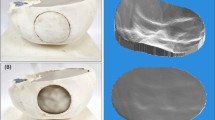Abstract
Microwave radiometry is a passive technique used to measure in-depth temperature distributions inside the human body, potentially useful in clinical applications. Experimental data imply that it may provide the capability of detecting in-depth local variations of temperature and/or conductivity of excitable tissues at microwave frequencies. Specifically, microwave radiometry may allow the real-time monitoring of brain temperature and/or conductivity changes, associated with local brain activation. In this paper, recent results of our ongoing research regarding the capabilities of focused microwave radiometry for brain intracranial applications are presented. Electromagnetic and thermal simulation analysis was performed using an anatomically detailed head model and a dielectric cap as matching medium placed around it, in order to improve the sensitivity and the focusing attributes of the system. The theoretical results were compared to experimental data elicited while exploring that the sensing depth and spatial resolution of the proposed imaging method at 2.1 GHz areas located 3 cm deep inside the brain can be measured, while at 2.5 GHz, the sensing area is confined specifically to the area of interest. The results exhibit the system’s potential as a complementary brain imaging tool for multifrequency in-depth passive monitoring which could be clinically useful for therapeutic, diagnostic, and research applications.








Similar content being viewed by others
References
Karanasiou I (2015) Imaging of conductivity changes of excitable tissues based on focused passive microwave. Open Biomed Eng J 9:138
Rodrigues DB, Maccarini PF, Salahi S et al (2014) Design and optimization of an ultra wideband and compact microwave antenna for radiometric monitoring of brain temperature. IEEE Trans Biomed Eng 61:2154–2160
Stauffer PR, Snow BW, Rodrigues DB et al (2014) Non-invasive measurement of brain temperature with microwave radiometry: demonstration in a head phantom and clinical case. Neuroradiol J 27:3–12
Arunachalam K, Maccarini P, De Luca V et al (2011) Detection of vesicoureteral reflux using microwave radiometry—system characterization with tissue phantoms. IEEE Trans Biomed Eng 58:1629–1636
Kostopoulos SA, Savva AD, Asvestas PA, et al (2015) Early breast cancer detection method based on a simulation study of single-channel passive microwave radiometry imaging. In: J. Phys. Conf. Ser. IOP Publishing, p 012120
Benetos G, Toutouzas K, Drakopoulou M et al (2015) Predictive accuracy of microwave radiometry in symptomatic carotid plaque identification in ischemic stroke. J Am Coll Cardiol 65:A2059
Rodrigues DB, Maccarini PF, Louie S, et al (2013) Numerical 3D modeling of heat transfer in human tissues for microwave radiometry monitoring of brown fat metabolism. In: SPIE BiOS. International Society for Optics and Photonics, p 85840S–85840S
Jacobsen S, Stauffer PR (2007) Can we settle with single-band radiometric temperature monitoring during hyperthermia treatment of chestwall recurrence of breast cancer using a dual-mode transceiving applicator? Phys Med Biol 52:911
Jacobsen S, Stauffer PR, Neuman DG (2000) Dual-mode antenna design for microwave heating and noninvasive thermometry of superficial tissue disease. IEEE Trans Biomed Eng 47:1500–1509
Birkelund Y, Klemetsen Ø, Jacobsen SK et al (2011) Vesicoureteral reflux in children: a phantom study of microwave heating and radiometric thermometry of pediatric bladder. IEEE Trans Biomed Eng 58:3269–3278
Arunachalam K, Maccarini PF, De Luca V et al (2010) Modeling the detectability of vesicoureteral reflux using microwave radiometry. Phys Med Biol 55:5417
Maruyma K, Mizushina S, Sugiura T et al (2000) Feasibility of noninvasive measurement of deep brain temperature in newborn infants by multifrequency microwave radiometry. IEEE Trans Microw Theory Tech 48:2141–2147
Karathanasis KT, Gouzouasis I, Karanasiou IS et al (2010) Noninvasive focused monitoring and irradiation of head tissue phantoms at microwave frequencies. IEEE Trans Inf Technol Biomed 14:657–663
Karanasiou IS, Uzunoglu NK, Papageorgiou CC (2004) Towards functional noninvasive imaging of excitable tissues inside the human body using focused microwave radiometry. IEEE Trans Microw Theory Tech 52:1898–1908
Karanasiou I, Uzunoglu NK, Stergiopoulos S, Wong W (2004) A passive 3D imaging thermograph using microwave radiometry. ITBM-RBM 25:227–239
Karanasiou I, Uzunoglu N (2004) Experimental study of 3D contactless conductivity detection using microwave radiometry: a possible method for investigation of brain conductivity fluctuations. IEEE:2303–2306
Karathanasis KT, Gouzouasis I, Karanasiou IS et al (2012) Experimental study of a hybrid microwave radiometry—hyperthermia apparatus with the use of an anatomical head phantom. IEEE Trans Inf Technol Biomed 16:241–247
Gouzouasis IA, Karathanasis KT, Karanasiou IS, Uzunoglu NK (2010) Contactless passive diagnosis for brain intracranial applications: a study using dielectric matching materials. Bioelectromagnetics 31:335–349
Karanasiou I, Uzunoglu N (2006) The inverse problem of a passive multiband microwave intracranial imaging method. In: Eng. Med. Biol. Soc. 2005 IEEE-EMBS 2005 27th Annu. Int. Conf. Of. IEEE, pp 1642–1645
Hasgall P, Neufeld E, Gosselin M, et al (2015) IT’IS Database for thermal and electromagnetic parameters of biological tissues. Version 30. 10.13099/VIP21000-03-0
SEMCAD Reference manual for the SEMCAD simulation platform for electromagnetic compatibility, antenna design and dosimetry
Gabriel C, Gabriel S, Corthout E (1996) The dielectric properties of biological tissues: I. Literature survey. Phys Med Biol 41:2231
Gabriel S, Lau R, Gabriel C (1996) The dielectric properties of biological tissues: II. Measurements in the frequency range 10 Hz to 20 GHz. Phys Med Biol 41:2251
Gabriel S, Lau R, Gabriel C (1996) The dielectric properties of biological tissues: III. Parametric models for the dielectric spectrum of tissues. Phys Med Biol 41:2271
Jalilvand M, Li X, Zwirello L, Zwick T (2015) Ultra wideband compact near-field imaging system for breast cancer detection. IET Microw. Antennas Amp Propag
Acknowledgements
The authors would like to thank Schmid & Partner Engineering AG (SPEAG) for providing the license for SEMCAD-X software through SEMCAD X for Science agreement (www.speag.com).
Author information
Authors and Affiliations
Corresponding author
Rights and permissions
About this article
Cite this article
Koutsoupidou, M., Groumpas, E., Karanasiou, I.S. et al. The effect of using a dielectric matching medium in focused microwave radiometry: an anatomically detailed head model study. Med Biol Eng Comput 56, 809–816 (2018). https://doi.org/10.1007/s11517-017-1729-4
Received:
Accepted:
Published:
Issue Date:
DOI: https://doi.org/10.1007/s11517-017-1729-4




